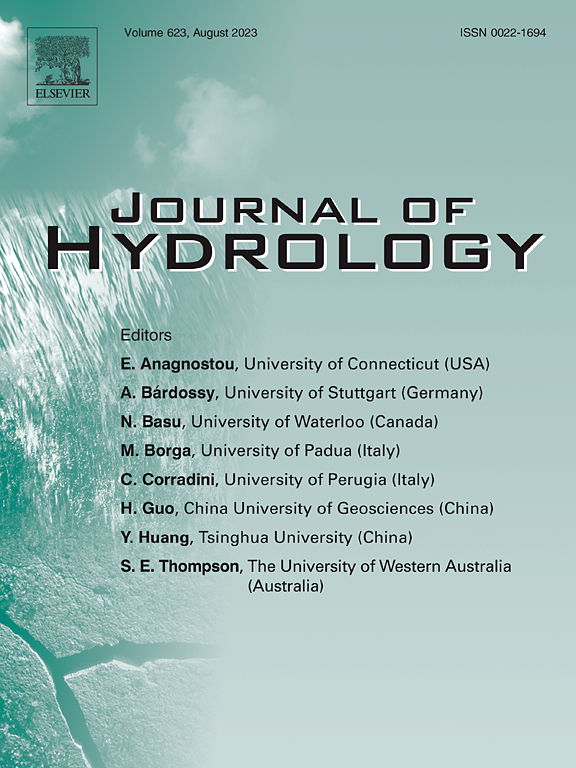Assessing local uncertainty of intrinsic groundwater vulnerability using nonparametric geostatistics: A probabilistic approach
IF 6.3
1区 地球科学
Q1 ENGINEERING, CIVIL
引用次数: 0
Abstract
Uncertainty is inherent in the evaluation of groundwater vulnerability, and modeling uncertainty is crucial for decision-making related to groundwater resources management. This study investigated local uncertainty of the DRASTIC model established for the Pingtung Plain, Taiwan, using indicator kriging and nonparametric Monte Carlo simulation. Local uncertainty of classifying the ratings of DRASTIC parameters was probabilistically measured using one minus the largest conditional probability and local entropy (LE). Sensitivity analysis was employed to analyze an integrating uncertainty derived from weighted averages of the probabilistic measures. Local uncertainty of variations of DRASTIC vulnerability indices (DVIs) was stochastically measured using interquartile range (IQR) and conditional variance (CV). Spearman’s rank correlations were used to analyze local uncertainty of key DRASTIC parameters influencing that of DVIs. The results revealed that the measures of local uncertainty were considerably consistent with one minus the largest conditional probability and LE for classifying the ratings of DRASTIC parameters and IQR and CV for rating variations of DVIs, demonstrating a reliable result of uncertainty assessment. The local uncertainty of the groundwater depth (i.e., D parameter) considerably influenced that of the DRASTIC model. To reduce uncertainty, increasing wells for monitoring groundwater levels should be considered in determined groundwater protection zones with high DVIs and high uncertainty.

利用非参数地质统计评估地下水固有脆弱性的局部不确定性:一种概率方法
地下水脆弱性评价的不确定性是固有的,建模的不确定性对地下水资源管理决策至关重要。利用指标克里格和非参数蒙特卡罗模拟方法,研究了台湾屏东平原DRASTIC模型的局部不确定性。用1减去最大条件概率和局部熵(LE)对DRASTIC参数分级分类的局部不确定性进行了概率测量。灵敏度分析用于分析由概率测度的加权平均值产生的积分不确定性。采用四分位差(IQR)和条件方差(CV)随机测量剧烈脆弱性指数(DVIs)变化的局部不确定性。采用Spearman秩相关分析影响dvi的关键DRASTIC参数的局部不确定性。结果表明,局部不确定性的度量与1减去最大条件概率和LE对DRASTIC参数评级的分类以及对dvi评级变化的IQR和CV相当一致,证明了不确定性评估的可靠结果。地下水深度的局部不确定性(即D参数)对DRASTIC模型的不确定性影响较大。为减少不确定性,在确定的高dvi、高不确定性的地下水保护区,应考虑增加地下水水位监测井。
本文章由计算机程序翻译,如有差异,请以英文原文为准。
求助全文
约1分钟内获得全文
求助全文
来源期刊

Journal of Hydrology
地学-地球科学综合
CiteScore
11.00
自引率
12.50%
发文量
1309
审稿时长
7.5 months
期刊介绍:
The Journal of Hydrology publishes original research papers and comprehensive reviews in all the subfields of the hydrological sciences including water based management and policy issues that impact on economics and society. These comprise, but are not limited to the physical, chemical, biogeochemical, stochastic and systems aspects of surface and groundwater hydrology, hydrometeorology and hydrogeology. Relevant topics incorporating the insights and methodologies of disciplines such as climatology, water resource systems, hydraulics, agrohydrology, geomorphology, soil science, instrumentation and remote sensing, civil and environmental engineering are included. Social science perspectives on hydrological problems such as resource and ecological economics, environmental sociology, psychology and behavioural science, management and policy analysis are also invited. Multi-and interdisciplinary analyses of hydrological problems are within scope. The science published in the Journal of Hydrology is relevant to catchment scales rather than exclusively to a local scale or site.
 求助内容:
求助内容: 应助结果提醒方式:
应助结果提醒方式:


